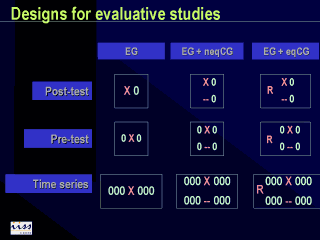| front |1 |2 |3 |4 |5 |6 |7 |8 |9 |10 |11 |12 |13 |14 |15 |16 |17 |18 |19 |review |
 R: random assignation --- : without random assignation 0 : measurement or observation X : Intervention evaluated EG: Experimental group CG: Control group |
Numerous useful research tools
can be deployed in evaluative research. Among them are: Experimental designs (Pre-test post-test with equivalent CG or Post-test with equivalent CG) Quasi-experimental designs (Pre-test post-test with non-equivalent CG, Simple or multiple chronological series) Pre-experimental designs (Study of unique case, Pre-test post-test of a single group and Post-test with 2 groups) Designs that include a control group generate the best quality evidence in evaluative research, because they make it possible to control the confounding effect of concomitant prognostic variables. Ideally, the equivalent CG is formed by subjects who are similar to the EG, except they do not receive X. The CG is called “equivalent” if the subjects are assigned randomly, and “non-equivalent” when selection is not random. The CG may be subject to intervention: If the objective is to make a decision between two alternative actions, the CG may receive a different version of the same intervention or another intervention. In studies that do not compare alternatives, the CG may receive no intervention at all, or a placebo. |